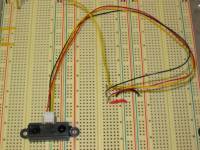Table of Contents
Infrared
Summary
Introduction
Infrared waves are those just below the visible spectrum of frequencies. Collectively they have wavelengths of 0.7 to 300µm. (Liew 1997).
Examples
A noncontact system capable of detecting position is over the range of one meter is the Sharp GP2D12. This sensor is comprised of an LED and position sensitive detector (PSD). The PSD is a silicon component that operates on the principle of the photoelectric effect, in which light energy is turned into electrical energy. The top of the PSD contains photosensitive material, and attached to the left and right ends of the device are output current leads. For a focused beam, such as one produced by a laser, the ratio of the output currents are proportional to the location at which the beam strikes the PSD; equal currents indicate that the beam has struck at the middle of the PSD. This dual output system eliminates the strength of the reflected beam from the equation of position. This is necessary as every surface has a different reflection coefficient.
In the infrared sensor, a narrow band infrared beam is transmitted from the LED. When the beam strikes an object it is reflected back towards the sensor and into a focusing lens. The focusing lens directs the refleted beam onto the PSD. The incident angle of the reflected beam is determined by the distance from the sensor to the reflecting object; the farther away the reflecting object is, the slighter the angle. As a consequence of the narrow band of propogation, there is a minimum distance away from the LED the reflecting object needs to be in order for the beam to reflect upon the focusing lens. Furthermore, as the reflecting object moves farther and farther away, the change in angle at which the reflected beam decreases; i.e. sensitivity decreases.
The location at which the reflected beam strikes the PSD is thus determined by the distance between the transmitter and the reflecting object. The ratiometric output currents generated by the PSD are compared internally in the sensor, and translated into an output voltage.
This infrared sensor can be used to sense objects from 10 to 80 cm away. It is generally immune from noise, but somewhat susceptible to fluorescent light.
Infrared sensing is commonly employed in astronomical observations, as it serves as added information about the cosmos.
Devices
| Sharp GP2D12 / GP2D15 | |
|---|---|
| Sources | Digi-Key CAN$ 16.03 Future Electronics Jaco Acroname US$ 12.50 Robot Italy € 16.8 |
| Description | General Purpose Type Distance Measuring Sensors |
| Datasheet | SharpGP2D12.pdf |
| Resources | GP2D12 Distance Sensor - Explains how to build an interface for this sensor. |
| Notes | Extremely easy to use!!! |
| Variants | |
Media
External links & references
- Liew, S. C., 1997, Principles of remote sensing. Centre for Remote Imaging, Sensing, and Processing, National University of Singapore.

